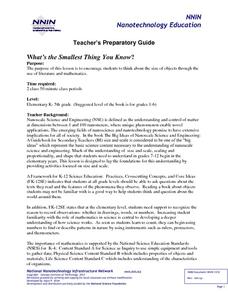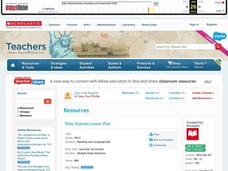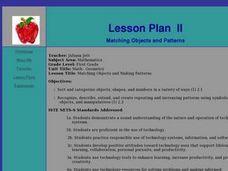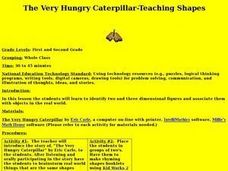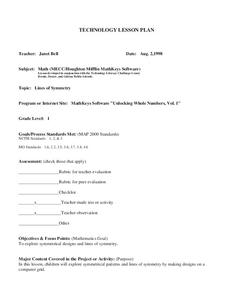National Nanotechnology Infrastructure Network
What’s the Smallest Thing You Know?
Elementary learners listen to a story, then sort objects from largest to smallest at six different stations around the classroom. Adaptable for a large range of age and ability groups.
Curated OER
Learning about Shapes with Tangrams and the Net
Pupils use tangrams, student literature, and Websites to explore shapes.
Curated OER
Veggie Chop and Data Analysis
First graders chop vegetables into fractions. In this fractions lesson plan, 1st graders cut vegetables, collect data about favorite vegetables and create a bar graph using the information. Students make inferences about the data...
Curated OER
Ramps 2: Ramp Builder
Students design, build, and test their own ramps. They are introduced to a variety of materials and explore putting them together. Students engage in an inquiry-based learning experience to reinforce math, science, and technology...
Curated OER
Polar Express Lesson Plan
Students write and illustrate a wish for the first gift of Christmas. In this Christmas lesson plan, students read the book The Polar Express and then write what they wish could be the first gift of Christmas.
Curated OER
Teaching With the Power of Objects
Students define value of an object. In this value lesson plan, students identify reasons for collecting objects, compile a personal inventory of items they find valuable, and then define why those items are valuable to them. In step two...
Curated OER
Students Speak Up -- Lesson 2
Students define new words such as computer, internet and technology to begin the lesson. In groups, they discuss the definitions with the class and take a survey on the same topics. They discuss the ways technology and the internet can...
Curated OER
Sequencing Events
Using The Very Hungry Caterpillar by Eric Carle, pupils practice sequencing events in a story. After reading the story, they head to the computer lab to use Kidspiration to sequence events. Then they create their own books to demonstrate...
Curated OER
Introduction to Hours & Minutes
First graders identify, interpret, and gain proficiency in using a clock to tell time to the hour and determine how many minutes are in an hour. They identify and list what they do as they travel through their dayand how much time you...
Curated OER
Matching Objects and Patterns
First graders participate in hands-on activities and use objects to create patterns. They observe a PowerPoint instructional activity describing matching objects and patterns. In groups, 1st graders complete geometry computer activities...
Curated OER
The Very Hungry Caterpillar - Teaching Shapes
Students identify two- and three-dimensional figures and associate them with real-world objects. In this geometry lesson, students are read The Very Hungry Caterpillar by Eric Carle and complete several activities including a chart...
Curated OER
The Very Grouchy Ladybug: Telling Time
Students practice telling time by reading a children's story. For this time keeping lesson, students read the book The Very Grouchy Ladybug by Eric Carl, and create a schedule for the ladybug to complete certain activities....
Curated OER
Creating AB Patterns
Students work with patterns. In this pattern lesson, students find AB patterns in nature and the manmade world. They create their own AB pattern using math manipulatives and visual arts.
Curated OER
Science of Special Effects
This is a creative, multidisciplinary, well-designed instructional activity provided by Scientific American related to special effects. Students make their own animated short films and use math and computer skills.
Curated OER
Pick a Pet
Students construct a pictograph of favorite pets. In this pets and graphing lesson, students discuss their favorite pet and use animal magazines to find their favorite pets and cut them out. Students create a pictograph using the pictures.
Curated OER
Lines of Symmetry
First graders create symmetrical designs using a computer program. In this lines of symmetry lesson, 1st graders review their symmetrical designs and discuss other ways symmetrical designs can be made. Students work in pairs...
Curated OER
Teddy Bears Everywhere
Students explore the history of teddy bears. In this comprehension lesson, students bring a bear of their own to compare and contrast with their classmates. Students read book and discuss the events and draw pictures of the scenes.
Curated OER
Let's Learn about Symmetry
Students explore symmetry in architecture. In this cross curriculum art and architecture lesson, students fold paper to illustrate symmetry and identify symmetrical and asymmetrical shapes. Students observe photographs...
Curated OER
Pancakes, Pancakes!- Measuring
Students estimate measurements in real world problem situations. In this estimation instructional activity, students read the book Pancakes, Pancakes and estimate how many cups equal a pint, quart, and gallon. Students test their...
Curated OER
The "Art" of Baseball
Young scholars investigate the art of baseball. In this sports lesson, students discuss their thoughts about the sport of baseball and create a baseball word list. Young scholars use pattern blocks and drawing paper to...
Curated OER
The Human Memory
This is a well-designed, creative lesson to help students learn more about the human memory. Working in pairs, students complete tasks and gather data. Excellent websites for resources are also provided.
Curated OER
Coin Count & Classification
Students make a prediction about how 100 pennies sort by decade or year and then test their predictions. They organize their data using a graph that is imbedded in this lesson.
Curated OER
Ancient Peoples of the Middle East
This is an excellent multidisciplinary lesson designed by Scientific American. It provides three creative activities--designing a garden, studying hieroglyphics, and writing poetry--relevant to the ancient peoples of the Middle East....
Curated OER
What is It? Susie Sees!
Students explore the five senses. In this cross curriculum five senses lesson, students view an "I Can See Colors" PowerPoint presentation and sort items by color and shape. Students mix primary color paints to create secondary...
